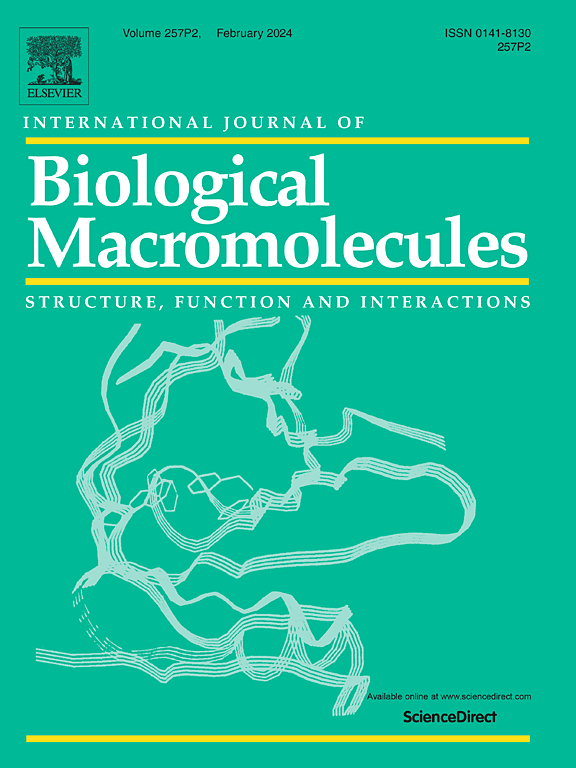Circular RNAs in glioma progression: Fundamental mechanisms and therapeutic potential: A review
IF 8.5
1区 化学
Q1 BIOCHEMISTRY & MOLECULAR BIOLOGY
International Journal of Biological Macromolecules
Pub Date : 2025-05-17
DOI:10.1016/j.ijbiomac.2025.144360
引用次数: 0
Abstract
Gliomas are the most common primary malignant brain tumors, characterized by aggressive invasion, limited therapeutic options, and poor prognosis. Despite advances in surgery, radiotherapy, and chemotherapy, the median survival of glioma patients remains disappointingly low. Therefore, identifying glioma-associated therapeutic targets and biomarkers is of significant clinical importance. Circular RNAs (circRNAs) are a class of naturally occurring long non-coding RNAs (lncRNAs), notable for their stability and evolutionary conservation. Increasing evidence indicates that circRNA expression is dysregulated in gliomas compared to adjacent non-tumor tissues and contributes to the regulation of glioma-related biological processes. Furthermore, numerous circRNAs function as oncogenes or tumor suppressors, mediating glioma initiation, progression, and resistance to temozolomide (TMZ). Mechanistically, circRNAs regulate glioma biology through diverse pathways, including acting as miRNA sponges, binding RNA-binding proteins (RBPs), modulating transcription, and even encoding functional peptides. These features highlight the potential of circRNAs as diagnostic and prognostic biomarkers, as well as therapeutic targets for glioma. This review summarizes the dysregulation and functions of circRNAs in glioma and explores key mechanisms through which they mediate tumor progression, including DNA damage repair, programmed cell death (PCD), angiogenesis, and metabolic reprogramming. Our aim is to provide a comprehensive perspective on the multifaceted roles of circRNAs in glioma and to highlight their potential for translational application in targeted therapy.
环状rna在胶质瘤进展中的作用:基本机制和治疗潜力
胶质瘤是最常见的原发性恶性脑肿瘤,其特点是侵袭性强,治疗选择有限,预后差。尽管手术、放疗和化疗都取得了进展,但胶质瘤患者的中位生存率仍然低得令人失望。因此,确定胶质瘤相关的治疗靶点和生物标志物具有重要的临床意义。环状rna (circRNAs)是一类天然存在的长链非编码rna (lncRNAs),以其稳定性和进化保守性而闻名。越来越多的证据表明,与邻近的非肿瘤组织相比,胶质瘤中的circRNA表达失调,并有助于调节胶质瘤相关的生物学过程。此外,许多circrna作为癌基因或肿瘤抑制因子,介导胶质瘤的发生、进展和对替莫唑胺(TMZ)的耐药性。在机制上,环状rna通过多种途径调节胶质瘤生物学,包括作为miRNA海绵,结合rna结合蛋白(rbp),调节转录,甚至编码功能肽。这些特征突出了环状rna作为胶质瘤的诊断和预后生物标志物以及治疗靶点的潜力。本文综述了神经胶质瘤中环状rna的失调和功能,并探讨了它们介导肿瘤进展的关键机制,包括DNA损伤修复、程序性细胞死亡(PCD)、血管生成和代谢重编程。我们的目标是提供一个关于环状rna在胶质瘤中的多方面作用的全面视角,并强调它们在靶向治疗中的转化应用潜力。
本文章由计算机程序翻译,如有差异,请以英文原文为准。
求助全文
约1分钟内获得全文
求助全文
来源期刊
CiteScore
13.70
自引率
9.80%
发文量
2728
审稿时长
64 days
期刊介绍:
The International Journal of Biological Macromolecules is a well-established international journal dedicated to research on the chemical and biological aspects of natural macromolecules. Focusing on proteins, macromolecular carbohydrates, glycoproteins, proteoglycans, lignins, biological poly-acids, and nucleic acids, the journal presents the latest findings in molecular structure, properties, biological activities, interactions, modifications, and functional properties. Papers must offer new and novel insights, encompassing related model systems, structural conformational studies, theoretical developments, and analytical techniques. Each paper is required to primarily focus on at least one named biological macromolecule, reflected in the title, abstract, and text.

 求助内容:
求助内容: 应助结果提醒方式:
应助结果提醒方式:


